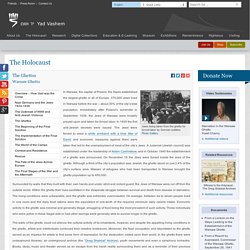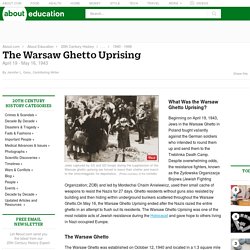

Ed Herman: My Warsaw Ghetto Memories. Economist Ed Herman was born a Jew in Warsaw, Poland in 1931.

Against the odds, he managed to survive the Holocaust as a child. Here, he recounts his escape and reflects on what it was like to return to his birthplace. After an absence of 68 years, my wife and I returned to Poland in August 2011. We had no intention of ever going back, as we did not want to think of all the things that had happened to us there, but went because The World Federation of Jewish Child Survivors of the Holocaust, whose meetings we had attended a few times before, were meeting in Warsaw Poland, where both of us were born. The first day of the conference started on Aug. 20, 2011, our 50th wedding anniversary, and the trip gave us an opportunity to retrace the years of our lost childhoods.
Reliving the past was very difficult emotionally. “Although I had documents stating that I am a Christian, it was always easy to discover my true identity because of my circumcision. After my retirement we moved to St. Holocaust History - Warsaw Ghetto. Jews being taken from the ghetto for forced labor by German soldiers Photo Gallery.

Warsaw Ghetto Uprising. What Was the Warsaw Ghetto Uprising?

Beginning on April 19, 1943, Jews in the Warsaw Ghetto in Poland fought valiantly against the German soldiers who intended to round them up and send them to the Treblinka Death Camp. Despite overwhelming odds, the resistance fighters, known as the Zydowska Organizacja Bojowa (Jewish Fighting Organization; ZOB) and led by Mordechai Chaim Anielewicz, used their small cache of weapons to resist the Nazis for 27 days. Ghetto residents without guns also resisted by building and then hiding within underground bunkers scattered throughout the Warsaw Ghetto. On. Girl's burnt diary reveals Warsaw ghetto horror.
Emerging from the shelter, she found the ghetto in flames and the dead body of her mother, who had been shot to death by gendarmes as she tried to prevent them raping a young neighbour.

She wrote: "Being drunk they wanted to have some 'fun'. My mother turned to those bandits. 'Leave her alone. What conscience do you have to take advantage of such a young girl? ' The answer was a shot which my mother received. " Debora was killed fighting in the Warsaw uprising of 1944, but her diary was recovered from her bombed-out home by her friend Lusia Schwarzwald Hornstein, who only revealed its existence on her deathbed in 1998. She asked that it be donated to the museum, but many of the pages, which cover January 1943 to mid-1944, had either been burnt or were stuck together, making it largely unreadable. But through painstaking work, curators at the museum have managed to transform the blackened fragments into a readable document by submerging it in de-ionised water. Warsaw Ghetto: A survivor's tale. 22 July 2012Last updated at 09:32 ET By Monica Whitlock BBC World Service Janina spent her early childhood in Kalisz, near the German border Janina Dawidowicz was a nine-year-old girl when World War II engulfed Poland.

As Jews, she and her family were soon driven into the Warsaw Ghetto, but she later escaped and remains one of its few survivors. Warsaw Ghetto Uprising - World War II. Shortly after the German invasion of Poland, in September 1939, more than 400,000 Jews in Warsaw, the capital, were confined to an area of the city that was little more than 1 square mile.

In November 1940, this ghetto was sealed off by brick walls, barbed wire and armed guards, and anyone caught leaving was shot on sight. The Nazis controlled the amount of food that was brought into the ghetto, and disease and starvation killed thousands each month. (Ghettos were established in cities throughout Nazi-occupied Eastern Europe.
The Warsaw Ghetto. The Warsaw Ghetto Warsaw became the capital of Poland in 1596, the city flanks both sides of the Vistula River, two thirds of the cities area lying on the west bank and one third on the east bank.

Jewish people lived in Warsaw from the 15th century, and during the 19th century the Jewish population of Warsaw grew rapidly, becoming the largest Jewish community in Europe, and by the 20th century the world’s second largest behind New York. Jews were to be found in every part of the city, but predominantly in the Northern part, with many apartment houses and certain streets inhabited exclusively by Jews. In 1935 the city limits covered an area of 54 square miles with a population of 1.3 million people. Everyday Life in the Warsaw Ghetto Part 1/7: Introduction.